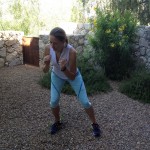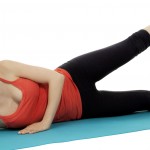Perceived Exertion
 If you exercise regularly – great, because maintaining a regular fitness routine can be a challenge. A common quandary many people run into is understanding HOW to exercise effectively. If you do the exact same workout day in and day out you will soon find yourself in the dreaded fitness rut or exercise plateau. You’ll know it when you stop seeing progress despite the usual effort put in. In this case, effort is (usually) the solution as in changing your effort or intensity of exercise. The good news is, what was once challenging to do is now easier and this is a testament of your hard work. BUT, as your body adapts to the workload you’ve given it, you need to also continue to progress or increase the difficulty of the work you’re asking your body to do. A great way to do this is using a heart rate monitor or monitoring your heart rate manually. Not everyone can afford or like to wear a monitor and even fewer know how to properly measure their own heart rate, especially during intense exercise. The other caveat to this is as your fitness level increases; your heart rate response will change too. So, to avoid all this, a very simple and free method to monitor your progress and intensity is using Perceived Exertion or PE. This incorporates a number scale to rate how you’re feeling before, during and after your workout. Use the scale to determine the amount of effort, fatigue or even pain you experience during different types of exercise or at different times throughout your workout. You’ll want to rate your breathing or respiratory effort, your muscle fatigue and your overall feeling (often respiratory and muscle are not the same). The best part is the scale naturally adapts to your progress so, as long as you’re consistent in how you use it, you will automatically be at just the right intensity you want to be.
If you exercise regularly – great, because maintaining a regular fitness routine can be a challenge. A common quandary many people run into is understanding HOW to exercise effectively. If you do the exact same workout day in and day out you will soon find yourself in the dreaded fitness rut or exercise plateau. You’ll know it when you stop seeing progress despite the usual effort put in. In this case, effort is (usually) the solution as in changing your effort or intensity of exercise. The good news is, what was once challenging to do is now easier and this is a testament of your hard work. BUT, as your body adapts to the workload you’ve given it, you need to also continue to progress or increase the difficulty of the work you’re asking your body to do. A great way to do this is using a heart rate monitor or monitoring your heart rate manually. Not everyone can afford or like to wear a monitor and even fewer know how to properly measure their own heart rate, especially during intense exercise. The other caveat to this is as your fitness level increases; your heart rate response will change too. So, to avoid all this, a very simple and free method to monitor your progress and intensity is using Perceived Exertion or PE. This incorporates a number scale to rate how you’re feeling before, during and after your workout. Use the scale to determine the amount of effort, fatigue or even pain you experience during different types of exercise or at different times throughout your workout. You’ll want to rate your breathing or respiratory effort, your muscle fatigue and your overall feeling (often respiratory and muscle are not the same). The best part is the scale naturally adapts to your progress so, as long as you’re consistent in how you use it, you will automatically be at just the right intensity you want to be.
The official PE scale is with Borg’s scale, using a numerical rating of 6-20. A PE of 6 would be equivalent to lying down and resting and a PE of 20 is equivalent to a full out, nothing left maximal effort. Efforts of PE 13-15 would be considered hard to very hard.
If this is confusing you can just use a scale of 1-10, where 1 is no effort and 10 is all you’ve got. PEs of 5-7.5 would be where you want to be for most workouts. Less than 5 would be ideal for warm up and cooldown. Going to PEs over 8 will be useful for measuring high intensity but short duration drills, which are ideal for interval training.
As you get used to using the scale of PE you choose, you’ll immediately know when it’s time to kick it up a notch as weights, distances, and/or speeds that used to be a 7 or 8 in intensity feel more like a 6. As long as you train for the intensity and not stick to the same old, same old, your body will continue to work, adapt and change and you will continue to see the changes in your fitness and health.



















